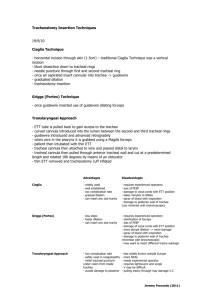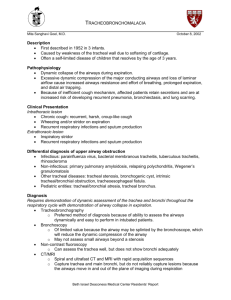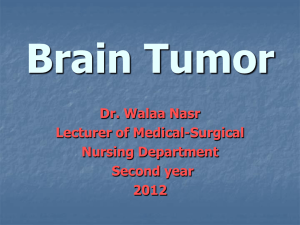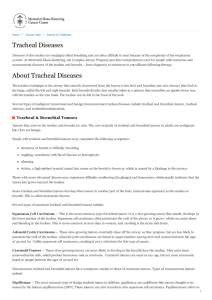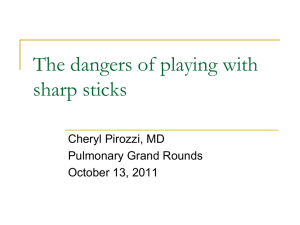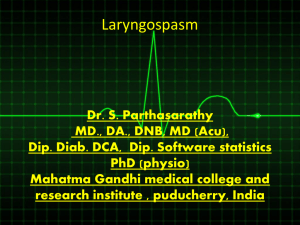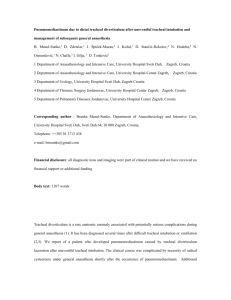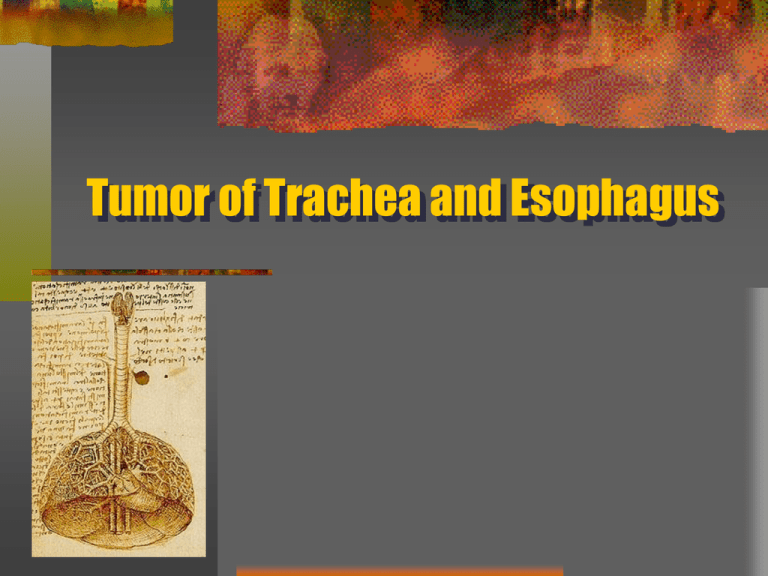
Tumor of Trachea and Esophagus
Tracheal neoplasm
Overview
Tracheal anatomy
Primary tracheal tumors
Benign primary tracheal tumors
Malignant primary tracheal neoplasms
Secondary tracheal tumors
Anatomy:
Trachea
Anatomy:
Trachea
Fibromuscular tube
Support by cartilagenous rings
Lower border of cricoid cartilage –
top of the carina spur
Average length 11 cm (10-13 cm)
Adult trachea 2-2.5 cm in
diameter
Extrathoracic trachea ~ 6-9 cm
C shaped with posterior
membranous wall
connecting the arms of the
“C”
Mucosa : a ciliated
pseudostratified columnar
epithelium
Anatomy:
Blood supply to trachea
Branches of inferior thyroid
artery supply the upper trachea
Branches of bronchial artery
supply the lower trachea
Branches arrive the trachea via
lateral pedicles
Tumor of trachea
Tracheal tumor 2 type
- primary tracheal tumor
- secondary tracheal tumor
Tracheal resection with end to end
anastomosis
Tracheal mobilization maneuvers
Extreme flexion of the neck (1-6 cm)
Incising the annular ligament (1-2 cm)
Suprahyoid or infrahyoid release of the upper
laryngotracheal unit (2.5-5 cm)
Blunt dissection and mobilization of the lower tracheal
segment (0.5-1 cm)
All combinations yields 4-6 cm (~ patient age and
range of neck motion)
Primary Tracheal Tumors
Primary Tracheal Tumors
Uncommon
Incidence 2 case/million/year
Men = Women
Peak age : 50- 59 yr
Risk factor : Smoking
In adults : Malignant >80%
In children : Benign > 90 %
Most frequent : proximal and distal 1/3 of trachea
Originate from any layer in tracheal wall
Classified : - Epithelial tumors
- Mesenchymal tumors
Cummings, 5 th ed.
Classification of Tracheal Tumors
Epithelial Neoplasms
Benign
Squamous cell papilloma
Papillomatosis
Pleomorphic adenoma
Malignant
Squamous cell carcinoma
Adenoid cystic carcinoma
Carcinoid
Mucoepidermoid carcinoma
Adenocarcinoma
Small-cell undifferentiated carcinoma
Secondary malignancy
Invasion by adjacent malignancy
Metastases
Nonneoplastic tumors
Tracheobronchopathia osteochondroplastica
Amyloidosis
Inflammatory pseudotumor
Mesenchymal Neoplasms
Benign
Fibroma
Hemangioma
Granular cell tumor
Schwannoma
Neurofibroma
Fibrous histiocytoma
Pseudosarcoma
Hemangioendothelioma
Leiomyoma
Chondroma
Chondroblastoma
Lipoma
Malignant
Leiomyosarcoma
Chondrosarcoma
Paraganglioma
Spindle-cell sarcoma
Lymphoma
Malignant fibrous histiocytoma
Rhabdomyosarcoma
BENIGN PRIMARY
TRACHEAL TUMORS
Benign primary tracheal tumors
Uncommon in adult
Usually smooth, well circumscribe, round, soft, and
small < 2 cm
Chest CT
Not extend through the tracheal wall
May presence of calcium within the lesion benign histology
Cummings, 5 th ed.
Benign primary tracheal tumors
Squamous papilloma
Granular cell tumor
Chondroma
Leiomyoma
Hemangioma
Squamous Papilloma
Superficial, sessile or papillary masses
consisting of a connective tissue core
covered by squamous epithelium
Adult : rare
: associate with heavy smoking
Children : most common tracheal
neoplasm
Cause : HPV 6, 11
Cummings, 5 th ed.
Squamous Papilloma
Cause : transmitted from mother to fetus during childbirth
Frequent recurs and difficult to completely eradicate
Usually regresses spontaneously after puberty
Major lesion occur isolated to the larynx (90-95%)
- 11% occur in the trachea in addition to the larynx
- 1.2 % isolated to the trachea
Squamous Papilloma
Treatment : similar laryngeal papilloma
- recent : CO2 laser
: Adjuvant treatment with α-interferon
Malignant transformation to SCCA or Verrucous CA
- incidence of malignant degeneration 1.6-4.0 %
- associated HPV -11
Granular cell tumor
Neurogenic in origin , from schwann cell
No sex predilection
Children : rare
50% of granular cell occur in the head and neck
region
- 10 % in the larynx
- rare : in the cervical trachea
Granular cell tumor
20% Multicentric tumor, more aggressive
Finding : Non-encapsulated,
: tend to invade locally
Malignant degeneration 1-2%
(never report in children)
Granular cell tumor
Management : surgery
- Tumor size < 8 mm :
“ Bronchoscopic resection ”
- Tumor size > 8 mm
high likelihood of full-thickness wall involvement
recurrent after bronchoscopic removal
“ Segmental tracheal resection ”
Chondroma
Most common benign mesenchymal tracheal tumor
Cartilaginous origin
Most common site
- internal aspect of the posterior cricoid lamina
Hard , smooth , broad-based and covered by intact
mucosa
Radiography : 75% found calcification,
not distinguish from chondrosarcoma
Chondroma
Management :
- surgery segmental tracheal resection
- endoscopic resection for palliation but leads to
recurrence
Leiomyoma
Origin : smooth muscle of tracheal wall , typically
from the membranous portion of the lower third of
the trachea
Finding : Smooth contoured ,
polypoid mass and usually have
a broad base
Leiomyoma
Management : surgery
- segmental tracheal resection
- incomplete resection local recurrence
Hemangioma
Hemangioma of the airway occur in adults and
children
In adult
- cavernous hemangiomas develop in the larynx
- capillary hemangioma originate in subglottic area
Hemangioma
Tracheal Hemangioma occur more often in young
children and most common obstructive subglottic mass
Asymptomatic at birth, but most will cause stridor within
the first 6 months of life
Cutaneous hemangioma 50% of patient

